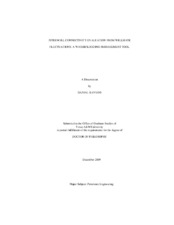| dc.description.abstract | Using injection and production data, we can evaluate the connectivity between injector and producer well pairs to characterize their interwell regions and provide a tool for waterflood management. The capacitance model (CM) has been suggested as a phenomenological method to analyze the injection and production data for these purposes. Early studies involving reservoir simulation have shown CM to be a valuable tool but also have revealed several shortcomings. Many of these deficiencies have become more transparent in analyzing field data. This work consists of two parts: in the first part, we investigate some of the shortcomings of the CM and attempt to overcome them by modifying the algorithms. In the second part, we relate the problem of interwell connectivity to the rigorous concept of Multiwell Productivity Index (MPI) and provide a semi analytical approach.
We have developed two modifications on the CM: the segmented CM that can be used where bottomhole pressures (BHP) are unknown and may change during the analysis interval, and the compensated CM that overcomes the requirement to rerun the model after adding a new producer or shutting in an existing producer. If both BHP changes and shut-in periods occur, the segmented and compensated CMs can be used simultaneously to construct a single model for a period of data. We show several hypothetical cases and a field case where these modifications generate a more reliable evaluation of interwell connectivity and increase the R2 of the model up to 15%.
On the other hand, the MPI-based approach can predict the reservoir performance analytically for homogeneous cases under specific conditions. In the heterogeneous cases, this approach provides a robust connectivity parameter, which solely represents the reservoir heterogeneity and possible anisotropy and hence allows improved information exchange with the geologist. In addition, this connectivity parameter is insensitive to possible variations of skin factor and changes in number of wells. A further advantage of the new method is the flexibility to incorporate additional information, such as injector BHP, into the analysis process. We applied this approach on several hypothetical cases and observed excellent evaluation of both reservoir performance and connectivity. | en |


